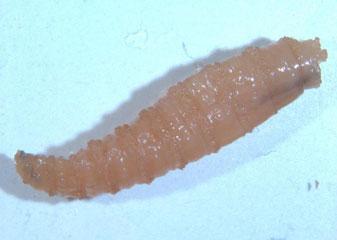Cochliomyia hominivorax (Coquerel) (ITIS; name is valid but unverified)
New World screwworm, primary screwworm
South America and the Caribbean (CFSPH 2012)
Eradicated in the U.S. in 1966 (ARS 1992)
Could be reintroduced to the U.S. from an infested animal (CFSPH 2012)
Parasite that kills livestock and wildlife, particularly cattle (CFSPH 2012)
Not currently established

Screwworm, larva(e)
Photo by Lesley Ingram
Find more images
Spotlights
All Resources
Selected Resources
The section below contains highly relevant resources for this species, organized by source.
Federal Government
State and Local Government
ARS. 1992. Subduing the screwworm. Agricultural Research.
Center for Food Security and Public Health. 2006. Fast Facts: Screwworm [PDF, 95 KB]. Iowa State University.
Center for Food Security and Public Health. 2012. Screwworm Myiasis [PDF, 252 KB]. Iowa State University.
Integrated Taxonomic Information System. Cochliomyia hominivorax. [Accessed Sep 22, 2023].
